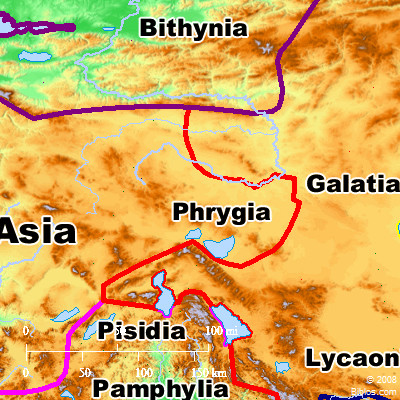Atlas  Phrygia and surrounding area Maps Created using Biblemapper 3.0 Additional data from OpenBible.info You are free to use up to 50 Biblos coprighted maps (small or large) for your website or presentation. Please credit Biblos.com. Occurrences Acts 2:10 Phrygia, Pamphylia, Egypt, the parts of Libya around Cyrene, visitors from Rome, both Jews and proselytes,Acts 16:6 When they had gone through the region of Phrygia and Galatia, they were forbidden by the Holy Spirit to speak the word in Asia. Acts 18:23 Having spent some time there, he departed, and went through the region of Galatia, and Phrygia, in order, establishing all the disciples. Encyclopedia PHRYGIAfrij'-i-a (Phrugia): A large ancient country of Central Asia Minor, very mountainous and with table-lands reaching 4,000 ft. in height. Its name is derived from Phryges, a tribe from Thrace, which in early times invaded the country and drove out or absorbed the earlier Asiatic inhabitants, among whom were the Hittites. Thus, the Phrygians borrowed much of oriental civilization, especially of art and mythology which they transferred to Europe. To define the boundaries of Phrygia would be exceedingly difficult, for as in the case of other Asia Minor countries, they were always vague and they shifted with nearly every age. The entire country abounds with ruins of former cities and with almost countless rock-hewn tombs, some of which are of very great antiquity. Among the most interesting of the rock sculptures are the beautiful tombs of the kings bearing the names Midas and Gordius, with which classical tradition has made us familiar. It seems that at one period the country may have extended to the Hellespont, even including Troy, but later the Phrygians were driven toward the interior. In Roman times, however, when Paul journeyed there, the country was divided into two parts, one of which was known as Galatian Phrygia, and the other as Asian Phrygia, because it was a part of the Roman province of Asia, but the line between them was never sharply drawn. The Asian Phrygia was the larger of the two divisions, including the greater part of the older country; Galatian Phrygia was small, extending along the Pisidian Mountains, but among its important cities were Antioch, Iconium and Apollonia. About 295 A.D., when the province of Asia was no longer kept together, its different parts were known as Phrygia Prima and Phrygia Secunda. That part of Asia Minor is now ruled by a Turkish wall or governor whose residence is in Konia, the ancient Iconium. The population consists not only of Turks, but of Greeks, Armenians, Jews, Kurds and many small tribes of uncertain ancestry, and of peculiar customs and religious practices. The people live mostly in small villages which are scattered throughout the picturesque country. Sheep and goat raising are the leading industries; brigandage is common. According to Acts 2:10, Jews from Phrygia went to Jerusalem, and in Acts 18:23 we learn that many of them were influential and perhaps fanatical. According to Acts 16:6, Paul traversed the country while on his way from Lystra to Iconium and Antioch in Galatian Phrygia. Twice he entered Phrygia in Asia, but on his 2nd journey he was forbidden to preach there. Christianity was introduced into Phrygia by Paul and Barnabas, as we learn from Acts 13:4; Acts 16:1-6; 18:23, yet it did not spread there rapidly. Churches were later founded, perhaps by Timothy or by John, at Colosse, Laodicea and Hierapolis. PHRYGIA, a central district of Asia Minor, in the N.T. times, but very irregularly bounded, see map No. 7. It was on high tableland and at one time surrounded and touched by all the other provinces, with exception of Pontus. Strong's Greek G5435: PhrugiaPhrygia, a region of Asia Minor |



